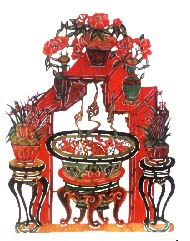
Legend has it that more than 2,000 years ago, Emperor Wudi (156-87 B.C.) of the Western Han Dynasty was very depressed with the death of his favorite concubine, Lady Li. To help him get over his sadness, Minister Li Shaoweng made a puppet out of cotton and silk in the likeness of the lady and projected its shadow on a curtain for the emperor to see. The show brought the emperor some consolation. He somehow believed the shadow was his lover's spirit.
Today, this is thought to be the beginning of the shadow show puppetry. Illuminated puppet figures manipulated by three to five artists using a transparent white cloth screen now form an artistic combination of opera, music, fine art and special craftsmanship.
An elaborate process goes into creating the puppets. Sheep or donkey skin is employed with the hair removed. The skin is cleaned and treated chemically to become thin enough to be translucent. It is then coated with tung oil and dried. Various dramatic figures are carved. The trunk, head and limbs of a puppet are separately carved, with thread used to join the parts so the puppets can simulate human movement. The puppets are painted various colors to show off their various qualities -- kind or wicked, beautiful or ugly.
During performances, "actors" are held close to a white curtain with their colored shadows cast on it by a strong light from behind. Moved by guiding sticks, the puppets play roles with musical accompaniment. Parts are played and sung by operators. The plays can be quite dramatic and, when it comes to fairy tales or kungfu stories, the "actors" may be made to ride on clouds or perform unusual feats, to the great enjoyment of the audience, especially children.
Shadow plays typical traditional entertainment and have survived and thrived over the centuries. They are also one of the earliest arts introduced by China into the West.
The shadow shows became quite popular as early as the Song Dynasty (960-1279) when holidays were marked by the presentation of many shadow plays. During the Ming (1368-1644), there were 40 to 50 shadow show troupes in the city of Beijing alone.
